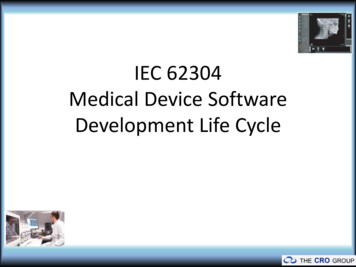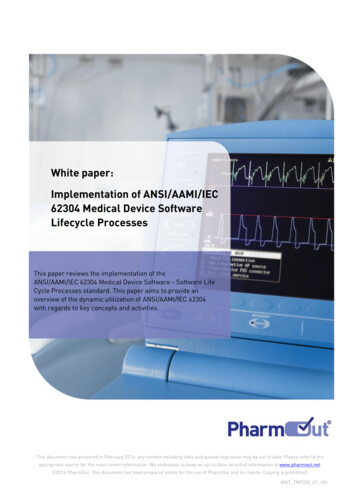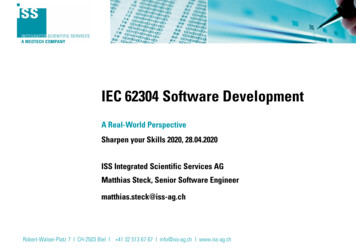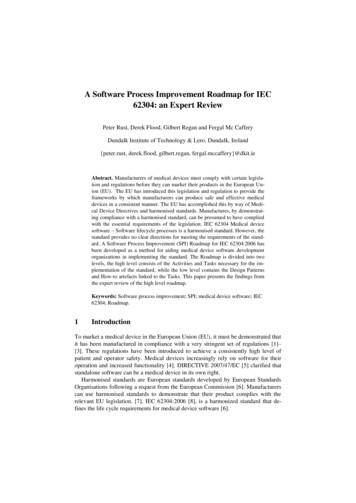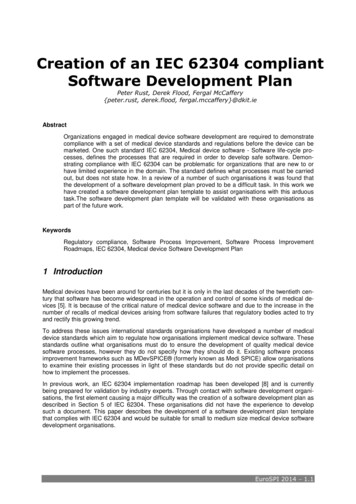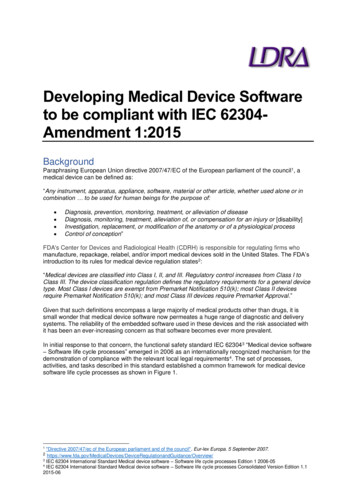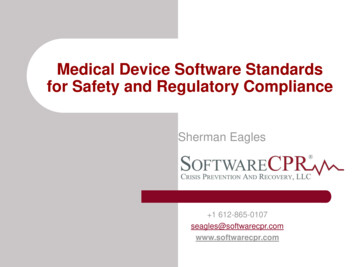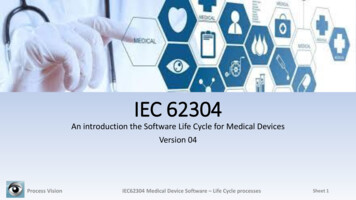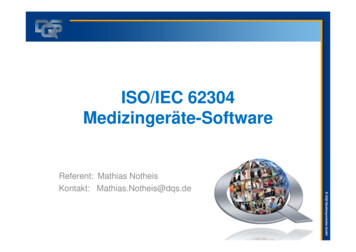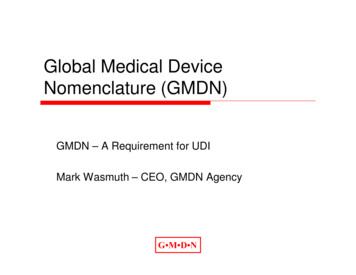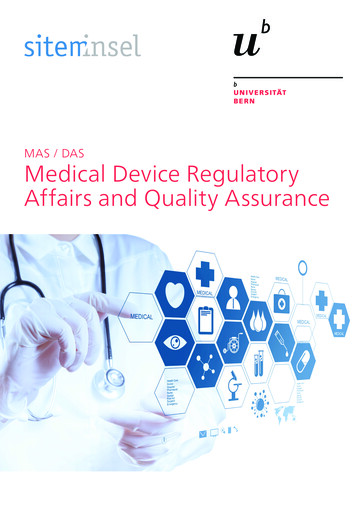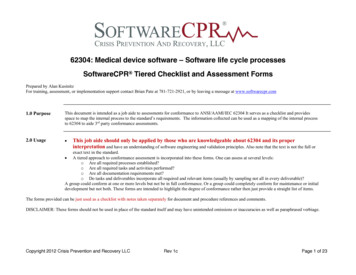
Transcription
62304: Medical device software – Software life cycle processesSoftwareCPR Tiered Checklist and Assessment FormsPrepared by Alan KusinitzFor training, assessment, or implementation support contact Brian Pate at 781-721-2921, or by leaving a message at www.softwarecpr.com1.0 PurposeThis document is intended as a job aide to assessments for conformance to ANSI/AAMI/IEC 62304 It serves as a checklist and providesspace to map the internal process to the standard’s requirements. The information collected can be used as a mapping of the internal processto 62304 to aide 3rd party conformance assessments.2.0 Usage This job aide should only be applied by those who are knowledgeable about 62304 and its properinterpretation and have an understanding of software engineering and validation principles. Also note that the text is not the full orexact text in the standard.A tiered approach to conformance assessment is incorporated into these forms. One can assess at several levels:o Are all required processes established?o Are all required tasks and activities performed?o Are all documentation requirements met?o Do tasks and deliverables incorporate all required and relevant items (usually by sampling not all in every deliverable)?A group could conform at one or more levels but not be in full conformance. Or a group could completely conform for maintenance or initialdevelopment but not both. These forms are intended to highlight the degree of conformance rather then just provide a straight list of items. The forms provided can be just used as a checklist with notes taken separately for document and procedure references and comments.DISCLAIMER: These forms should not be used in place of the standard itself and may have unintended omissions or inaccuracies as well as paraphrased verbiage.Copyright 2012 Crisis Prevention and Recovery LLCRev 1cPage 1 of 23
www.softwarecpr.comMain Office:15148 Springview StTampa, Florida 33624 USA781-721-2921Copyright Copyright 2008 Crisis Prevention and Recovery, LLC. (CPRLLC), all rights reserved. SoftwareCPR is a division of Crisis Prevention andRecovery, LLC and the SoftwareCPR logo is a registered trademark.SoftwareCPR authorizes its clients and SoftwareCPR.com subscribers use of this document for internal review and training. Any other use ordissemination of this document is expressly prohibited unless the document is provided to you directly from SoftwareCPR or you receive thewritten authorization of SoftwareCPR .Legal DisclaimerThe training document example that follows should only be applied in the appropriate context with oversight by regulatory and softwareprofessionals with direct knowledge and experience with the topics presented. The document should not be used as a cookbook or taken literallywithout knowledgeable evaluation of current interpretations and enforcement.While SoftwareCPR attempts to ensure the accuracy of information presented, no guarantees are made since regulatory interpretations andenforcement practices are constantly changing, and are not entirely uniform in their application.Disclaimer of Warranties: The information is provided AS IS, without warranties of any kind. CPRLLC does not represent or warrant that anyinformation or data provided herein is suitable for a particular purpose. CPRLLC hereby disclaims and negates any and all warranties, whetherexpress or implied, relating to such information and data, including the warranties of merchantability and fitness for a particular purpose.Copyright 2012 Crisis Prevention and Recovery LLCRev 1cPage 2 of 23
3.0 Identification and t/Product:Scope/portion of 62304 Assessed (Indicate 62304 included or excluded whichever is the shorter list):Depth of Assessment (Describe which tiers included and the degree of document review and interviewing):Performed by:Analysis and Conclusion:Copyright 2012 Crisis Prevention and Recovery LLCRev 1cPage 3 of 23
4. High-level Conformance EvaluationThe Procedure/Plan column is to note where the approach or method for the activity is defined. The deliverable/documents column is to note the output of the activity interms of documents and other deliverables that provide objective evidence that the process and activity was performed. One procedure, plan or document could bereferenced multiple times. If all elements of this table are satisfied, one demonstrates conformance with the processes and activities requirements of ANSI/AAMI/IEC62304. Note that ANSI/AAMI/IEC 62304 also requires specific tasks and these more detailed requirements are not addressed in this table.The “initially” column indicates whether the initial development was conformant and the “now” column indicates whether the current process is conformant.Enter NE if the requirement was NOT Evaluated. Enter NA if it is not applicable. These forms can be just used as a checklist with notes taken separately for documentand procedure references and comments.ANSI/AAMI/IEC 62304Initially(Y, N,NE)Now(Y, N,NE)Procedure, Plan TitlesDeliverables/documentsComments4.1 Conformance with 13485 or a nationalquality management system or a qualitymanagement system required by nationalregulation4.2 Medical Device Risk Managementstandard ISO 149714.3 Software safety classification5 Software development Process5.1.1 Software Development plan or plans.5.2 Software Requirements Analysis5.3 Software Architectural Design (no ClassA requirements)5.4. Software Detailed Design (no Class Arequirements)5.5 Software Unit Implementation andVerification5.6 Software integration and integrationtesting (no Class A requirements)5.7 SoftwareSystem Testing5.8 Software Release6 Software Maintenance Process6.1. Establish Software Maintenance PlanCopyright 2012 Crisis Prevention and Recovery LLCRev 1cPage 4 of 23
6.2 Problem and modification analysis6.3 Modification Implementation7 Software Risk Management Process(only Section 7.4.1 is required for Class A)7.1 Analysis of software contributing tohazardous situations7.2 Risk Control Measures7.3 Verification of Risk Control Measures7.4 Risk Management of Software Changes8 Software Configuration ManagementProcess8.1 Configuration Identification8.2 Change Control8.3 Configuration Status Accounting9 Software Problem Resolution Process9.1 Prepare Problem Reports9.2 Investigate the problem9.3 Advise relevant parties9.4 Use Change Control process9.5 Maintain records9.6 Analyse problems for trends9.7 Verify software problem resolution9.8 Test documentation contentsCopyright 2012 Crisis Prevention and Recovery LLCRev 1cPage 5 of 23
Software Safety ClassificationThe manufacturer shall assign to each software system a safety class according to the possible effects on the patient, operator, or other people resulting from a hazard towhich the software system can contribute. This is documented in the Risk Management file.§ Class A – No injury of damage to health is possible§ Class B – Non-serious injury is possible§ Class C – Death or serious injury is possibleThe manufacturer shall also identify safety classifications of each software item or group of items.System Class(A,B,C)Assessor Opinion on Software System ClassificationIf software items are not all the same, then use this as well to examine a sampling of items classified lower than the system classification.Identify Sampled Software Item ClassificationsAssessor Rationaleand highlight any with questionableClassificationCopyright 2012 Crisis Prevention and Recovery LLCRev 1cPage 6 of 23
62304 Processes Detailed Section by Section ChecklistThe processes below are required for the safety classifications indicated, unless the manufacturer documents in the Risk Management file a rationale for using a lowerclassification.UNLESS NOTED EACH CHECKLIST ITEM APPLIES TO ALL SAFETY CLASSESFor items that are outside the scope of the assessment use NE – not evaluated – and be clear about the scope of the assessment in any summary report or conclusions.For items that are not relevant use NA – not applicable – and document your rationale.NOTE: This checklist can be used to evaluate if plans and procedures address all relevant items but for a full assessment results of actual development and maintenanceshould be evaluated to determine if in practice all conformance was achieved with all items.5 Software Development Process5.1 Software development planningANSI/AAMI/IEC 62304 ConformityRequirementsY/ N/NE/NAProcedure, Plan, or Document references(If level of detail in section 4 is not considered a sufficientmapping)Comments5.1.1 a – e The software development/qualityplan(s) addresses:a. the processes to be usedb.c.d.the deliverables of the activities andtaskstraceabilty between systemrequirements, softwarerequirements, software system testand risk control measures.configuration and changemanagement including SOUPconfiguration items and softwareused for developmentCopyright 2012 Crisis Prevention and Recovery LLCRev 1cPage 7 of 23
e.software problem resolutionprocedure5.1.2 Software development/quality plan(s)get updated5.1.3 a. Software development plan(s)references system requirements as inputs5.1.3 b. The plan includes or referencesprocedures for coordinating the softwaredevelopment and the design and developmentvalidation necessary to meet qualitymanagement system requirements.5.1.4 Standards, methods and tools defined inplan(s).Class C.5.1.5 software integration and softwareintegration test are included in the plan.Including SOUP.Class B, C5.1.6 software verification plan(s) includea) deliverables requiring verification,b) the verification tasks required for each lifecycle activity,c) the milestones at which deliverables areverifiedd) acceptance criteria for verification5.1.7 Risk management planning is includedin the plan(s)and includes risk management related toSOUP.Copyright 2012 Crisis Prevention and Recovery LLCRev 1cPage 8 of 23
5.1.8 Documentation planning is included inthe plan(s) and includes the following fordocuments to be produced during thesoftware development life cycle:a) Title, name or naming conventionb) Purposec) Intended audienced) Procedures and responsibilities fordevelopment, review, approval andmodification.5.1.9 Plans include CM informationincluding:a. items to be controlled.b. SCM activities and tasksc,d. organizational responsibilities for CMe. points when the items are to be placedunder formal CMf. when the problem resolution process is tobe used.5.1.10 Supporting development tools, itemsor settings are included in CMClass B, C5.1.11 Plans require software items areplaced under formal CM before they areverified.Class B, CCopyright 2012 Crisis Prevention and Recovery LLCRev 1cPage 9 of 23
5.2 Software Requirements AnalysisSection Conformity RequirementsY/N/NE/NAProcedure, Plan, or Document references(If level of detail in section 4 is not considered a sufficientmapping)Comments5.2.1 software requirements are defined anddocumented from System Requirements.5.2. As appropriate check for the followingtypes of requirements5.2.2 a. include Functional and capabilityrequirements5.2.2 b. Software system inputs and outputs5.2.2 c. Interfaces between the softwaresystem and other systems.5.2.2 d. Alarms, warnings, operator messages5.2.2 e. Security5.2.2 f. Usability requirements that aresensitive to human error and training.5.2.2 g. Data Definition and databaserequirements5.2.2 h. Installation and acceptance reqs atthe operation and maintenance site.5.2.2 i. reqs for operation and Maintenance5.2.2 j. user documentation required5.2.2 k. user maintenance reqs5.2.2 l. regulatory reqs such as fromperformance standards for the device type,regulatory guidance documents forfunctionality for the device type, 5.2.3 risk control measures included as reqs.Class B, C5.2.4 device risk analysis re-evaluated andupdated based on software reqs.Copyright 2012 Crisis Prevention and Recovery LLCRev 1cPage 10 of 23
5.2.5 System requirements updated based onsoftware reqs5.2.6 Verify the software requirementsincluding that:a) system and risk control reqsimplemented.b) Do not contradict one anotherc) in terms minimizing ambiguityd) testablee) uniquely identifiedf) are traceable to System requirementsCopyright 2012 Crisis Prevention and Recovery LLCRev 1cPage 11 of 23
5.3 Software Architectural Design (No Class A requirements)Section Conformity RequirementsY/N/NE/NAProcedure, Plan, or Document references(If level of detail in section 4 is not considered a sufficientmapping)Comments5.3.1 Documented software architectureincluding structure and software items.Class B, C5.3.2 Documented architecture includes theinterfaces between the software items andbetween software items and externalcomponents (HW and SW).Class B, C5.3.3 Functional and performancerequirements are specified for SOUP items.Class B, C5.3.4 System hardware and softwarenecessary for SOUP items are specified.Class B, C5.3.5 segregation essential to risk control isspecified.Class C5.3.6 Verify and document the architectureincluding that it:a) implements system and software and riskcontrol reqsb) supports internal and external interfacesc) supports proper operation of SOUP itemsClass B, C5.4 Software Detailed Design (No Class A requirements)Section Conformity RequirementsY/N/NE/NAProcedure, Plan, or Document references(If level of detail in section 4 is not considered a sufficientmapping)Comments5.4.1 refine the architecture to the softwareunit level.Class B, CCopyright 2012 Crisis Prevention and Recovery LLCRev 1cPage 12 of 23
5.4.2 detailed design exists for each softwareunit.Class C5.4.3 Detailed design exists for the interfacesbetween the software units and betweensoftware units and external components (hwand software).Class C5.4.4. Verification that the detailed designa) implements the software architectureb) is free from contradiction with thearchitecture.Class C5.5 Software unit implementation and verificationSection Conformity RequirementsY/N/NE/NA
ANSI/AAMI/IEC 62304 Initially (Y, N, NE) Now (Y, N, NE) Procedure, Plan Titles Deliverables/documents Comments 4.1 Conformance with 13485 or a national quality management system or a quality management system required by national regulation 4.2 Medical Device Risk Management standard ISO 14971 4.3 Software safety classification
